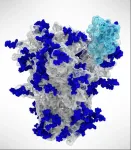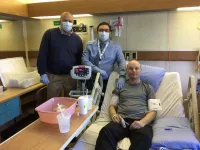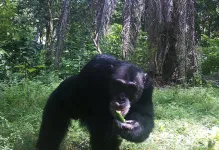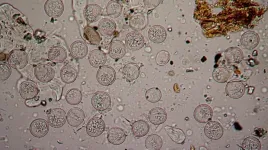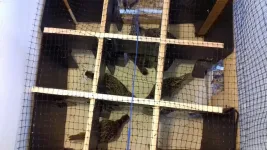Antibodies recognize and attack different SARS-CoV-2 spike shapes
The spikes on the SARS-CoV-2 virus, which causes COVID-19, change shapes; new research reveals ways that antibodies can recognize these different shapes and block the virus and informs the design of vaccines and antiviral therapies
2021-02-25
(Press-News.org) ROCKVILLE, MD - The virus that causes COVID-19 belongs to the family of coronaviruses, "corona" referring to the spikes on the viral surface. These spikes are not static--to infect cells, they change shapes. Maolin Lu, an associate research scientist at Yale University, directly visualized the changing shapes of those spike proteins and monitored how the shapes change when COVID-19 patient antibodies attach. Her work, which was published in Cell Host & Microbe in December 2020 and will be presented on Thursday, February 25 at the 65th Annual Meeting of the Biophysical Society informs the development of COVID-19 vaccines and treatments that target the spikes of the SARS-CoV-2 virus, which causes COVID-19.
When the COVID-19 pandemic hit, Lu was quick to apply her expertise studying the HIV-1 virus to SARS-CoV-2. Prior to the pandemic, Lu studied which shapes of the HIV-1 spikes are most susceptible to antibody attack. Using similar techniques, in March 2020, she turned to SARS-CoV-2.
Because the spike proteins are prominent on the outside of the SARS-CoV-2 virus, they are crucial targets for vaccines and therapeutics. The vaccines that have been approved so far have been designed to help the body generate antibodies that recognize this part of the SARS-CoV-2 virus, blocking its entry into cells. However, Lu says, "the spike protein constantly changes shape, this shape-shifting feature not only allows the virus to enter host cells, it also helps the virus escape from being attacked or recognized by antibodies."
Using an imaging technique to monitor molecular movements, Lu observed that it adopts at least four shapes. She also watched how the spike proteins responded to serum from patients who recovered from COVID-19, which contained antibodies their body made against the SARS-CoV-2 virus. She noticed that some antibodies recognized and attached to the spike protein when it was in an "open" position and ready to stick to cells. Others preferred to attach to a "closed" spike, which is the spike's dominant position when the virus first enters the body.
"This indicates that antibodies can attack or antagonize the SARS-CoV-2 spike two different ways. One way is to directly occupy the spike's open position, then the virus cannot get close or associate with the host cells. The other way is to lock the spike into a closed position. The second locking down strategy has been widely used to develop COVID-19 vaccines," Lu explained.
When it comes to developing new vaccines or treatments, their research shows that targeting the SARS-CoV-2 spike protein when it is in a closed position may be a particularly effective strategy.
INFORMATION:
[Attachments] See images for this press release:
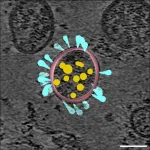
ELSE PRESS RELEASES FROM THIS DATE:
2021-02-25
ROCKVILLE, MD - One thing that makes SARS-CoV-2, the virus that causes COVID-19, elusive to the immune system is that it is covered in sugars called glycans. Once SARS-CoV-2 infects someone's body, it becomes covered in that person's unique glycans, making it difficult for the immune system to recognize the virus as something it needs to fight. Those glycans also play an important role in activating the virus. Terra Sztain-Pedone, a graduate student, and colleagues in the labs of Rommie Amaro at the University of California, San Diego and Lillian Chong at the University of Pittsburgh, studied exactly how the glycans activate SARS-CoV-2. Sztain-Pedone will present the research on Thursday, February 25 at the 65th Annual Meeting ...
2021-02-25
(Thursday, Feb. 25, 2021, Toronto)--Results of a world-first Canadian pilot study on patients treated with gene therapy for Fabry disease show that the treatment is working and safe.
The Canadian research team was the first to use gene therapy in 2017 to treat patients with Fabry disease, a rare, chronic illness that can damage major organs and shorten lives. They report their findings today in the journal Nature Communications.
"Being one of the first people in the world to receive this treatment, and seeing how much better I felt afterward, it definitely gives me hope that this can help many other Fabry patients and potentially those with other single gene mutation disorders," says Ryan Deveau, one of the ...
2021-02-25
Chimpanzees and humans "overlap" in their use of forests and even villages, new research shows.
Scientists used camera traps to track the movements of western chimpanzees - a critically endangered species - in Guinea-Bissau.
Chimpanzees used areas away from villages and agriculture more intensively, but entered land used by humans to get fruit - especially when wild fruits were scarce.
Researchers from the University of Exeter and Oxford Brookes University say the approach used in this study could help to inform a "coexistence strategy" for chimpanzees ...
2021-02-25
Allergy sufferers are no strangers to problems with pollen. But now - due to climate change - the pollen season is lasting longer and starting earlier than ever before, meaning more days of itchy eyes and runny noses. Warmer temperatures cause flowers to bloom earlier, while higher CO2 levels cause more pollen to be produced.
The effects of climate change on the pollen season have been studied at-length, and END ...
2021-02-25
Although guidelines do not recommend use of opioids to manage pain for individuals with knee osteoarthritis, a recent study published early online in END ...
2021-02-25
Liquid structures - liquid droplets that maintain a specific shape - are useful for a variety of applications, from food processing to cosmetics, medicine, and even petroleum extraction, but researchers have yet to tap into these exciting new materials' full potential because not much is known about how they form.
Now, a research team led by Berkeley Lab has captured real-time high-resolution videos of liquid structures taking shape as nanoparticle surfactants (NPSs) - soap-like particles just billionths of a meter in size - jam tightly together, ...
2021-02-25
Pheasants fall into two groups in terms of how they find their way around - and the different types prefer slightly different habitats, new research shows.
University of Exeter scientists tested whether individual pheasants used landmarks (allocentric) or their own position (egocentric) to learn the way through a maze.
The captive-bred pheasants were later released into the wild, and their choice of habitat was observed.
All pheasants favoured woodland, but allocentric navigators spent more time out in the open, where their landmark-based style is more useful.
"Humans tend to use both of these navigational tactics and quite frequently combine them, ...
2021-02-25
In a major advance in the treatment of multiple myeloma, a CAR T-cell therapy has generated deep, sustained remissions in patients who had relapsed from several previous therapies, an international clinical trial has found.
In a study posted online today by the New England Journal of Medicine, trial leaders report that almost 75% of the participants responded to the therapy, known as idecabtagene vicleucel (ide-cel), and one-third of them had a complete response, or disappearance of all signs of their cancer. These rates, and the duration of the responses, are significantly ...
2021-02-25
The genetic tool CRISPR has been likened to molecular scissors for its ability to snip out and replace genetic code within DNA.
But CRISPR has a capability that could make it useful beyond genetic repairs. "CRISPR can precisely locate specific genes," says Lacramioara Bintu, an assistant professor of bioengineering at Stanford. "What we did was attach CRISPR to nanobodies to help it perform specific actions when it reached the right spot on DNA."
Her lab recently used this combo technique to transform CRISPR from a gene-editing scissors into a nanoscale control agent that can toggle specific genes on and off, like a light switch, to start or stop the flow of some health-related protein inside a cell.
"There are a lot of things you can't fix ...
2021-02-25
Baby mice might be small, but they're tough, too.
For their first seven days of life, they have the special ability to regenerate damaged heart tissue.
Humans, on the other hand, aren't so lucky: any heart injuries we suffer could lead to permanent damage. But what if we could learn to repair our hearts, just like baby mice?
A team of researchers led by UNSW Sydney have developed a microchip that can help scientists study the regenerative potential of mice heart cells. This microchip - which combines microengineering with biomedicine - could help pave the way for new regenerative heart medicine research.
The study is featured on the cover ...
LAST 30 PRESS RELEASES:
[Press-News.org] Antibodies recognize and attack different SARS-CoV-2 spike shapes
The spikes on the SARS-CoV-2 virus, which causes COVID-19, change shapes; new research reveals ways that antibodies can recognize these different shapes and block the virus and informs the design of vaccines and antiviral therapies

